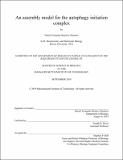| dc.contributor.advisor | Joseph H. Davis. | en_US |
| dc.contributor.author | Ramirez Montero, Daniel Fernando. | en_US |
| dc.contributor.other | Massachusetts Institute of Technology. Department of Biology. | en_US |
| dc.date.accessioned | 2020-02-10T21:37:32Z | |
| dc.date.available | 2020-02-10T21:37:32Z | |
| dc.date.copyright | 2019 | en_US |
| dc.date.issued | 2019 | en_US |
| dc.identifier.uri | https://hdl.handle.net/1721.1/123711 | |
| dc.description | This electronic version was submitted by the student author. The certified thesis is available in the Institute Archives and Special Collections. | en_US |
| dc.description | Thesis: S.M., Massachusetts Institute of Technology, Department of Biology, 2019 | en_US |
| dc.description | Cataloged from student-submitted PDF version of thesis. | en_US |
| dc.description | Includes bibliographical references (pages 59-64). | en_US |
| dc.description.abstract | Autophagy is a highly conserved eukaryotic homeostasis process that facilitates degradation of intracellular components. During times of starvation, autophagy is vital in replenishing pools of biosynthetic precursors through degradation of these cytosolic components, and it also plays key roles in responding to cytotoxic stress as it acts to specifically degrade damaged organelles, aggregated proteins, and pathogens. This is achieved by the formation of an autophagosome, a double membrane organelle that engulfs cytoplasmic components and then fuses with the vacuole or the lysosome leading to degradation of the engulfed components. Of note, defects in autophagy have been genetically linked with cancer, neurodegeneration, inflammation and aging, highlighting the importance of deeply understanding this process. Although several genetic screens have enumerated the proteins required for autophagy, our mechanistic understanding of how these proteins interact and function in autophagy is very limited. In this work, I focus on the most upstream autophagy protein complex, called the Atg1 complex or autophagy initiation complex (AIC), which binds high curvature lipid vesicles and is thought to catalyze their fusion to initiate autophagosome biogenesis. In chapters 1-4 of this work, I review what is currently known about different steps of the mechanism of AIC formation, its interactions with lipid vesicles and its putative functional role in initiating autophagosome formation, highlighting outstanding questions throughout. Finally, in Chapter 5, I describe my efforts to develop a new single-molecule approach to study the mechanism of AIC assembly, and discuss the important unanswered questions that this new approach may allow us to address. | en_US |
| dc.description.statementofresponsibility | by Daniel Fernando Ramirez Montero. | en_US |
| dc.format.extent | 64 pages | en_US |
| dc.language.iso | eng | en_US |
| dc.publisher | Massachusetts Institute of Technology | en_US |
| dc.rights | MIT theses are protected by copyright. They may be viewed, downloaded, or printed from this source but further reproduction or distribution in any format is prohibited without written permission. | en_US |
| dc.rights.uri | http://dspace.mit.edu/handle/1721.1/7582 | en_US |
| dc.subject | Biology. | en_US |
| dc.title | An assembly model for the autophagy initiation complex | en_US |
| dc.type | Thesis | en_US |
| dc.description.degree | S.M. | en_US |
| dc.contributor.department | Massachusetts Institute of Technology. Department of Biology | en_US |
| dc.identifier.oclc | 1138021907 | en_US |
| dc.description.collection | S.M. Massachusetts Institute of Technology, Department of Biology | en_US |
| dspace.imported | 2020-02-10T21:37:32Z | en_US |
| mit.thesis.degree | Master | en_US |
| mit.thesis.department | Bio | en_US |
